Movie Review By: Mr. Roboto
Year: 2011
Directed by: Shawn Levy
Written by: John Gatins (screenplay), Dan Gilroy and Jeremy Leven (story). Based on the short story “Steel” by Richard Matheson.
IMDB Reference
Degree of Cyberpunk Visuals: Moderate
Correlation to Cyberpunk Themes: Moderate
Key Cast Members:
Charlie Kenton: Hugh Jackman
Max Kenton: Dakota Goyo
Bailey Tallet: Evangeline Lilly
Rating: 6 out of 10

Serving up super-sized knuckle sandwiches.
Overview: In the first of many cyberpunk (hopefully) movies to come out in the next year or two, we see Wolverine (aka Hugh Jackman) trying his hand at some futuristic Robot Wars/BattleBots action. Make that Rock ‘Em Sock ‘Em Robots, as these machines are boxers as opposed to the spinners, flippers, etc. of the former TV programs.
The movie is based on Richard Matheson’s short story, but you will find it more closely mirrors another famous boxing movie.
The Story: Charlie Kenton used to be a prize fighter, but that was before fight fans wanted more violence and bloodshed leading to more extreme fighting like MMA and WWE wresting done for real. Before long, robots entered the arenas and forced humans out to the sidelines. It is now 2020 and Charlie is roaming the countryside with a beat-up rust-bucket robot called Ambush that gets destroyed by a bull in a county fair. He finds out his son’s mother died and he is to get custody, but wants the boy’s aunt to take him instead. He blackmails the woman’s rich husband to take Max when the couple return from Europe at the end of summer, and uses the money to buy a former world-champion robot. Charlie’s ego and inexperience with the robot’s voice-command system causes his new robot to be destroyed as well. While raiding an industrial junk yard for parts, Max finds a second generation sparring robot named Atom and believes he can be a champion fighter. Charlie is reluctant at first, but when Atom wins his first underground fight, he begins training it for bigger matches, including a World Robot Boxing title match with the champion, Zeus. All the while, he learns how to be a better father for Max.

“You’ll be able to spit nails, kid. Like the guy says, you’re gonna eat lightning and you’re gonna crap thunder. You’re gonna become a very dangerous… um, robot.”
Yo, Adrian! If you feel like you’ve seen this movie before, you must have have watched Sylvester Stallone in the original Rocky series. From IMDB’s Real Steel trivia section: You might recognize the moves in the championship fight coming from Rocky IV. The basic plot of Rocky is also present here. Even the champion robot’s name is an indirect reference.
All this similarity to Rocky has to make you wonder if Hollywood has run out of original ideas. Then again, Matheson’s short story has been turned into a Twilight Zone episode which in turn was parodied by The Simpsons.
On the ropes. Calling this movie cyberpunk wasn’t an easy decision. Themes like technology’s negative effect (the robots taking over a career path), man-machine fusion (the various robot controls, the autonomous Zeus), underground focus (the underground fight clubs), and the visuals are present. Themes of control over society and ubiquitous data access are not there, though a couple of times I felt like the all-mighty dollar was all that mattered to anyone. This might be the result of Levy’s decision to set the story in 2020 as opposed to further into the future:
“The whole reason it’s 2020 and not further in the future is because I knew this movie was going to be an underdog story and I didn’t want the distant futurism of extreme sci-fi. I wanted the world to feel really familiar, so that the characters would feel really relatable.”
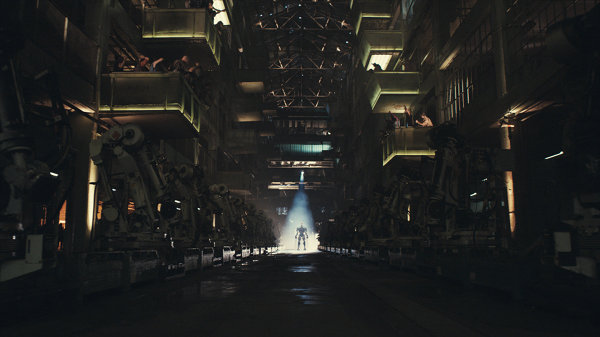
USELESS FACT: The Crash Palace is actually an old Ford Model T assembly plant in Highland Park, Michigan. Sean Levy thought it was perfect for the movie.
Speaking of the characters, they do work for this movie. Of course, it’s the robots who steel… steal the show, but the estranged-father-son-trying-to-reconnect story should give the non-robotic a few laughs and tears.
Conclusion: If you’ve watched Sly’s work, you’ve already seen this. Boxing-movie fans might find this worth adding to their video collection. For cyberpunk fans, it’s not a complete knockout, but those unfamiliar with Rocky might give this underdog their decision.
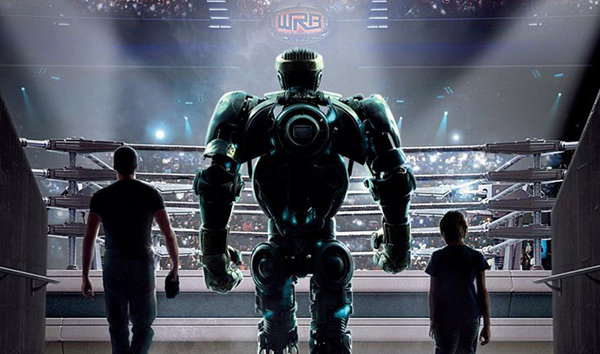
Welcome to the Big League.
Movie Review By: Mr. Roboto
Year: 2011
Directed by: Laszlo Kovacs
Written by: Laszlo Kovacs
** No IMDB Data Available **
Degree of Cyberpunk Visuals: Moderate
Correlation to Cyberpunk Themes: High
Key Cast Members:
Sue: Lisa Dee
Jazz: Andrew Hookway
Marshall Pax: Bryan Patrick Stoyle
Professor Michael Vanguard: Michael O’Hear
Enoch Crom: Timothy Dugan
Voros Farkash, Fallen Soldier, & Luddite Militia Member: Laszlo Kovacs
Rating: 6 out of 10
Overview: Our resident Cecil B. DeMille, Lazlo Kovacs, and his pals at Key Pixel have brought us the follow-up to the short underground fave UCF: Toronto Cybercide. The second chapter, Abstract Messiah, continues the story of Toronto’s rebuilding struggles as a new enemy come to the forefront determined to stop the cyborgs.
Kovacs said that the movie was about 98% complete and wanted to send a screener to preview. From what I’ve seen, it looks fairly ready for prime-time. Like many low-budget films, there are some issues to deal with, but they’re easy to overlook as long as you’re not expecting Blade Runner-quality fare.
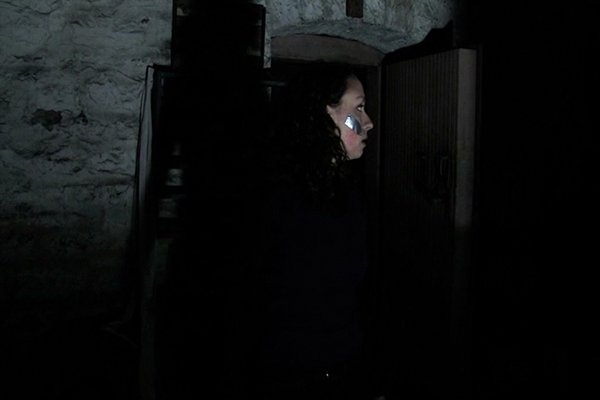
Duct tape is just a good as a band-aid.
The Story: Pax is called back to Toronto to retrieve the body of his former partner, and gets to meet up with his UCF mentor, a history professor. The professor is reported as kidnapped when he misses an appointment. Pax and company are called in to investigate when a member of the Luddites is considered the prime suspect. The investigation leads the UCF team to a prison for cyborgs where the Luddites plan to use the inmates in their ultimate plan; To use retrieve the nanotechnology in Pax’s deceased partner.
The game. A recurring theme is the chess game; Specifically, how the action is equivalent to moves and counter-moves on a chess board.
If that’s true then Equilibrium’s gun-fu scenes should be considered hands of Texas Hold-Em.
Seriously, every action movie would like to be compared to chess; That all the gun-play and violence has some intellectual reason and not just eye candy. For Abstract Messiah, they take the comparison to a new level starting with a real chess match between Pax and his Foundation mentor.

“While you were watching us learn, we were watching you teach.”
Such back and forth banter isn’t uncommon in action movies, as each side tries to impart their vision to the other. But when the two are bitter rivals, diametrical opposites of each other, that’s when the chess game quickly becomes an NBA-style trash talk fest, right before everyone STFU and lets their guns speak for them. Fortunately, Abstract Messiah doesn’t get to the trash-talk even though Crom does come off as the right-wingnut zealot type (nicely played). In fact, I keep getting this feeling that this movie is just one minor move in a much larger game.
Knuckle dusted. If there was a major problem with Abstract Messiah, it was the fight scenes. The fisticuffs weren’t all that convincing, but when a limited budget limits the use of professional stunt people you just have to use what you got and keep them safe for a possible part three.
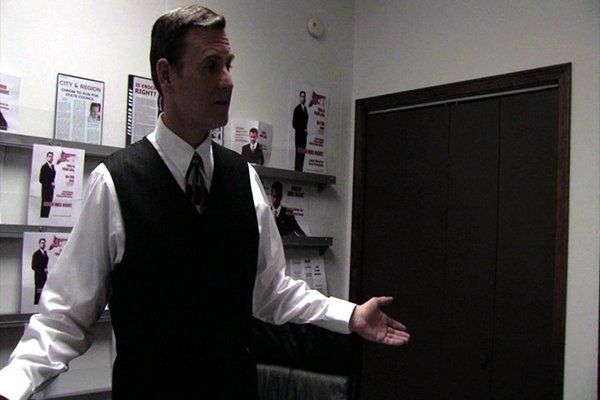
“The Luddites refuse to be slaves to the cybernetic machines, and I refuse to continue being a slave to the machinations of the Foundation.”
Conclusion: Since the original UCF short was released back in ‘06 there was a call for more of the Luddites. This should satisfy them for a good 80 minutes as the Luddites are now front and center.
Everyone should consider getting Abstract Messiah even if just to support indie movie makers like Key Pixel. Even with amateurish production on a shoe-string budget they still manage to make a movie that’s more watchable than what some major distributors with trillion-dollar purses have been cranking out lately.
One has to wonder what UCF 3 would be like, especially if they get a larger budget. Dare to dream… until Kovacs sends a PM saying he has a screener ready to preview.
Movie Review By: Mr. Roboto
Year: 2009
Directed by: Noboru Iguchi
Written by: Noboru Iguchi
IMDB Reference
Degree of Cyberpunk Visuals: Low
Correlation to Cyberpunk Themes: High
Key Cast Members:
Yoshie Kasuga: Aya Kiguchi
Kikue Kasuga: Hitomi Hasebe
Hikaru Kageno: Takumi Saitô
Onna Tengu 1: Asami
Onna Tengu 2: Cay Izumi
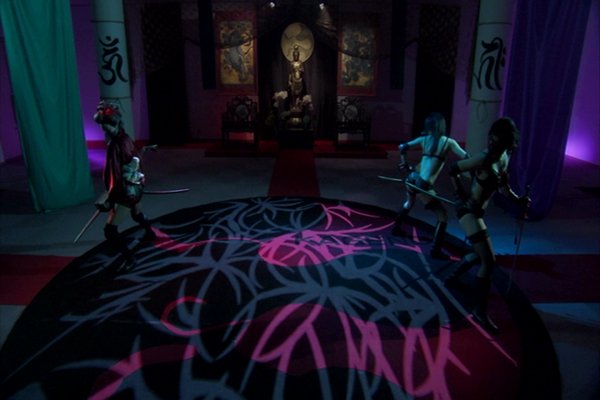
Official FAQ for RoboGeisha: It’s from Japan.
That is all.
Overview: Just when you thought Japanese cyberpunk couldn’t possibly get any stranger (or bloodier), evil genius Noboru Iguchi (Tokyo Gore Police) ups the ante… and bloodshed… with RoboGeisha.
Actually most of the bloodshed is in the unrated version; It was added via CGI for the DVD releases since Iguchi was asked to tone down the violence. But that still doesn’t degrade the overall weirdness, even with a sibling-rivalry storyline the would have worked better as standard-issue melodrama.
The Story: Yoshie (Aya Kiguchi) is a geisha’s attendant with dreams of becoming one herself. Her older sister, Kikue (Hitomi Hasebe), is the geisha who takes delight in keeping Yoshie’s dream unrealized. When the president of Kageno Steel Manufacturing discovers Yoshie’s hidden rage and fighting skills he wants to recruit her to join the Hidden Geishas, an army of cyberneticaly enhanced female assassins being trained to kill “corrupt” Japanese officials so the company can create its ideal world. But when Yoshie is given an assignment to kill a group of people whose family members have been kidnapped to become the Hidden Geishas, she soon discovers the company’s plans to destroy Japan.
As if trying to save Japan wasn’t hard enough, Yoshie is always trying to earn Kikue’s respect since she wasn’t getting any while trying to be a geisha. Yoshie does give Kikue a taste of her own medicine when she was chosen for the Hidden Geishas, until Kikue showed a predilection for killing. The two sisters compete as each wants to destroy the other, even though they show respect and love for each other as the company pushes its agenda forward.
1000 Ways to Die… Give or Take. When dealing with cyborgs and androids, you know someone is going to die. The main question is how? Iguchi manages to come up with some innovative ways…

USELESS FACT: About 70% of Japanese adults are lactose intolerant.
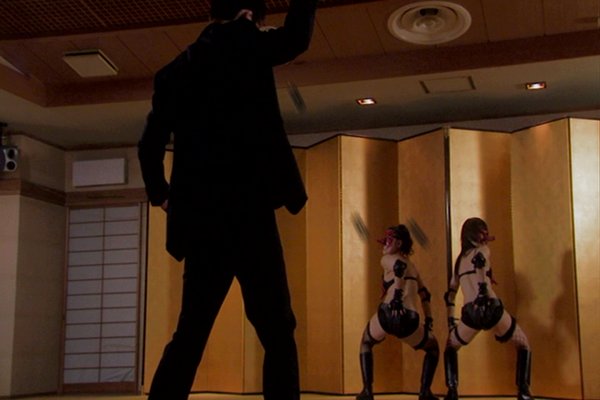
When you see it, you’ll shit… shurikens?
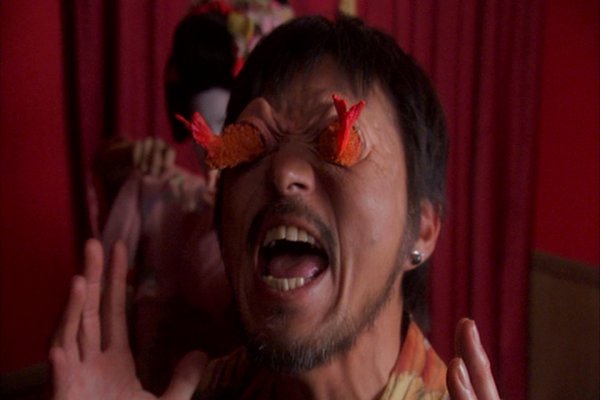
“The fried shrimp! They do NOTHING! I STILL CAN’T UNSEE!!!
Too much blood? Iguchi was asked to tone down the violence for RoboGeisha. He did for the theatrical release, but added it back for the DVDs. An interesting strategy, saving time on re-shoots and money on cleanups, but end result doesn’t really add much… other than blood (check this page that shows the comparison between theatrical and home releases). Even so, what was left in still looks cheesy, and even inappropriate at times, like when the giant shiro robot was stomping through town and stops to smash a couple of buildings that bleed.

Can someone get this poor girl a fresh tampon?
To compare to some other Japanese cyberpunk films, the violence in Tetsuo was more social commentary, while Tokyo Gore Police went for shock value. RoboGeisha’s violence tends to be more cartoonish, like Tom and Jerry with more splatter. Combine that with ass-katanas, lactating demon-cyborgs, and enough blood-cheese to rival Wisconsin and you’ll be ROFLMAO Zedong going ZOMGWTFKMFDMBBQ. That or you’ll just ask yourself…

Conclusion: So far, Japan’s track record for TFWO cyberpunk fare remains intact. RoboGeisha may be the best place to start for those who can’t stomach the more brutal stuff. Definitely shows that cyberpunk can have a sense of humor… a dark, disturbing, sick, twisted sense of humor…
Our thoughts and prayers go out to the people of Japan in the wake of the Sendai earthquake and tsunami and the Fukushima I nuclear plant accidents.
Movie Review By: Mr. Roboto
Year: 2009
Directed by: Jonathan Mostow
Written by: Michael Ferris & John D. Brancato
IMDB Reference
Degree of Cyberpunk Visuals: Low
Correlation to Cyberpunk Themes: Medium
Key Cast Members:
Greer: Bruce Willis
Peters: Radha Mitchell
Elder Cantor: James Cromwell
The Prophet: Ving Rhames
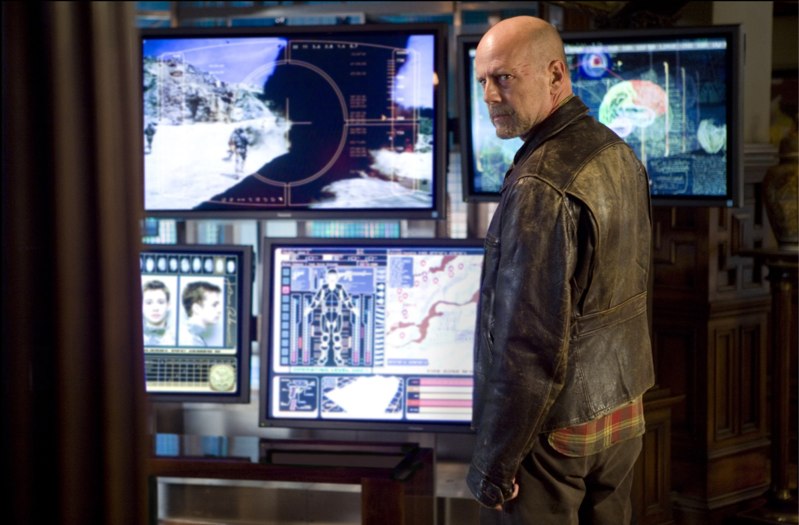
“What??? Only six stars? What happened?”
Overview: After reading the graphic novels, I thought I was ready for the movie. Unfortunately, Hollywood decided to “tweak” certain elements until there’s little left resembling the books. Not that ink-on-single-colors would work for a live-action film, but they could have left the action in Georgia instead of moving it to Boston, and leaving Greer (Harvey, not John) as a city detective as opposed to an FBI agent. While some “tweaking” might not have hurt, totally deviating from the books doesn’t. This could probably be traced to the trio of Mostow, Ferris, and Brancato, who were also behind the train-wreck of Terminator 3.
The good news is the message remained intact.
The Story: In a near future (no exact year given), humans spend all their time at home jacked into stem-chairs while piloting their surrogates, robotic avatars that interact in the real world now abandoned by humanity.
Two surrogates are destroyed by a mag-pulse type weapon. The destruction kills the operators, one of whom is the son of the surrogate’s inventor. FBI agent Greer searches for the weapon and is lead to the walled “Dread Nation” where his surrogate is destroyed by the anti-surrogate group. He continues without it as he probes deeper into a conspiracy that involves the military, Virtual Self Inc., the company behind the surrogate phenomenon, and the surrogate inventor, Dr. Cantor.

William Shatner, you are not.
What else went wrong? Another problem, other than the deviation from the books, is the look of the movie. Other than scenes showing the stem-chairs and a couple of scenes showing the “central control” of the surrogate grid, it is virtually impossible to tell if it is 2053 or 2009. Having live actors playing the robotic roles only adds to the confusion, though there were times where they not only looked like robots, but acted like robots. That was a surprisingly interesting touch.
… And the message? You can hear just as the movie starts: Does living life through a surrogate mean you’re actually living? Does being a robot make you less of a human? Have you been so plugged into your surrogate that you can’t unplug? And once you are unplugged… then what?
Those kind of questions about humanity being (over)connected to technology are what cyberpunk writers and fans have been asking since William Gibson’s first draft of Neuromancer.
Conclusion: If you’ve already read the books, the movie may only disappoint you with how far off it is. Bruce Willis fans and fans of action films may get a kick out Surrogates. Cyberpunk fans should find the message familiar, though you would be better off with the books.

“Holy father, I pray that you keep Jonathan Mostow, Michael Ferris, and John D. Brancato from ever making another cyberpunk movie, lest they cause the universe to collapse on itself.”
Movie Review By: hughie522
Year: 2004
Directed by: Jian Hong Kuo
Written by: Christopher Hatton
IMDB Reference
Degree of Cyberpunk Visuals: High
Correlation to Cyberpunk Themes: High
Key Cast Members:
- Dash MacKenzie: Genevieve O’Reilly
- Victor Huang: Luoyong Wang
Rating: 6 out of 10

SFAM NOTE: We welcome new reviewer hughie522, who uploaded this review into the Review Forum. If others are interested in joining the review team, please post a message in the review forum.
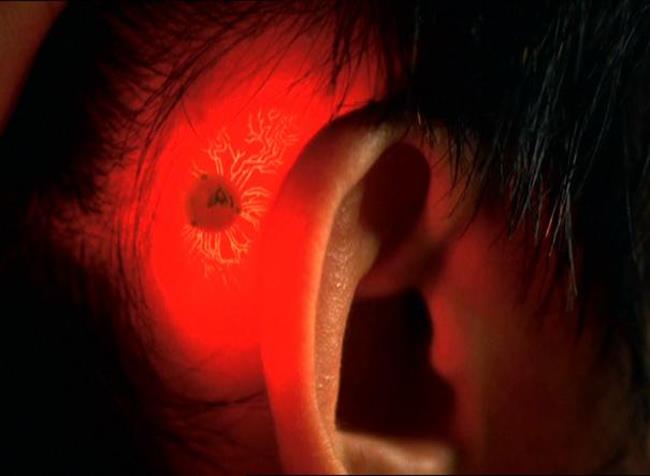
Overview: Few would consider Singapore to be the home of cutting-edge science fiction and even less would be swayed by the island nation’s first science fiction film, ‘Avatar’. The first forty minutes are cringe-worthy; poorly constructed characters, dodgy VFX and some of the worst dialogue outside a Ishiro Honda film are likely to put many viewers off straight away. However, ‘Avatar’ offers a little more than your cookie-cutter tale of good vs. evil wrapped in a sleek (if not cardboard-like) sci-fi setting. Transhumanism, corporate greed, social engineering, cheating death – all feature in an interesting little science fiction romp that unfortunately suffers from a very limited budget. Our story begins…
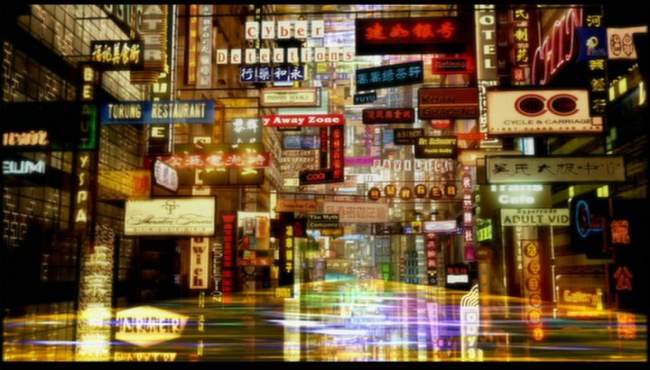
Synopsis: In the early 21st century, the entire free world is connected through the CyberLink (think ‘internet meets cyberspace’), the backbone of all communication and financial trading (ie. the stock exchange). The influence of the CyberLink is most felt in the city-state of Sintawan, a sprawling metropolis where corporate greed and personal gain rise above all else. Men (and women) such as Joseph Lau (David Warner, ladies and gentlemen!) are practically Gods over their own domain, the CyberLink ensuring their continued dominance over Sintawan through the megacorporations. Five megacorporations in particular – one of which is owned by Lau - appear locked in an epic game of wits with the people of Sintawan as the chess pieces.
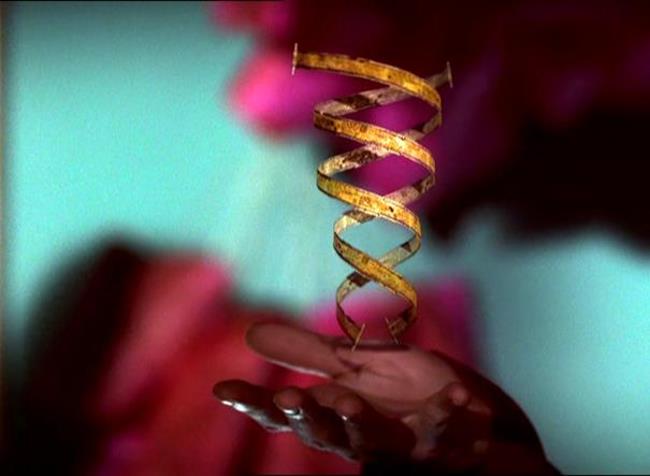
Not that the people actually realize this, oh no. They are too busy with their own private agendas to even notice! Although a vast majority of CyberLink users are legitimate, illegal users do exist and often use ‘SIMPLANTS’ to hide their true identities (sort of like using a disguise and a false ID). ‘SIMPLANT’-users are often tracked down by freelance bounty hunters such as Dash MacKenzie (O’Reilly) or, more commonly, by Ident cops such as Detective Vic Huang. Dash is contacted by Joseph Lau – as are the Ident Police – to track down an illegal ‘SIMPLANT’-user, Edward Chang. It seems straightforward enough, until Dash and Detective Huang discover a massive conspiracy involving the CyberLink, Joseph Lau and the other megacorporations. This game just got deadly…
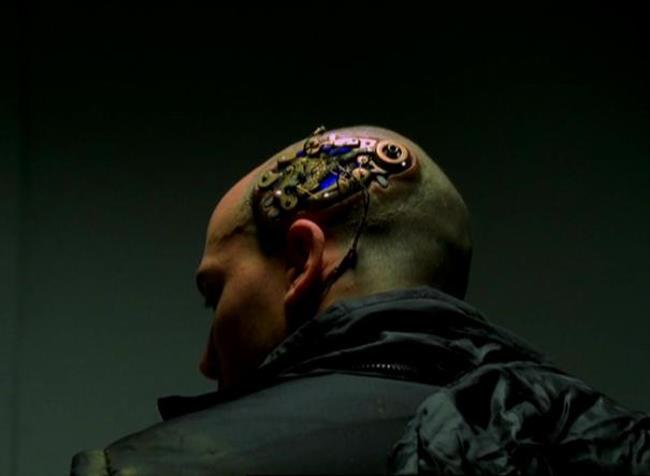
Analysis: To be frank, ‘Avatar’ is hardly ‘award-winning entertainment’ (though apparently it has already picked up two at a Spanish film festival) and will not blow anyone’s socks off. It is not destined to become a sci-fi classic or even a cult film, and is likely already forgotten by those that noticed it to begin with. Though it is not without its merits; the technology is fantastic: holograms are often used to hide the truth (such as disguising the fact that a prominent, five-star hotel is in desperate need of an exterminator and a few coats of paint), handheld communicators for video calls, micro-scale robots disguised as insects (such as beetles and dragonflies) that are used to project holograms and undertake surveillance, the concept of people that live inside the CyberLink and those that have augmented their bodies with technology (such as my friend below)…it is absolutely incredible that so much was achieved on such a limited budget.
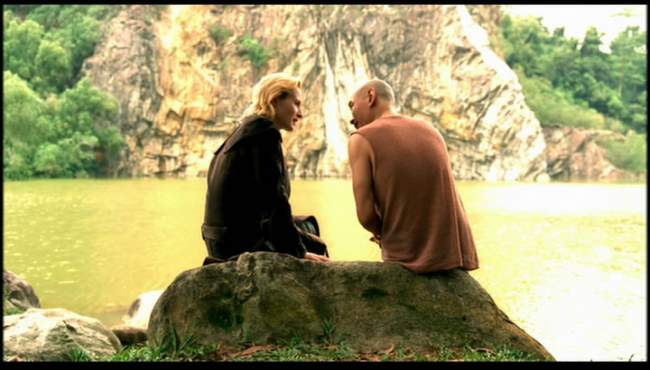
Cyberpunk Musings: There are a number of interesting aspects of Avatar which benefit from further exploration.
- Ravers: Ravers are part of Sintawan’s subculture. Augmented human beings with a gang mentality, they are fiercely anti-corporate and anti-government. Ravers are all connected through a telepathic link-up that is separate from the CyberLink and frequently use ‘crash-bangs’ (handheld electromagnetic pulse devices) to damage the city-state’s infrastructure (ie. at one point in the film an organised group of ravers attempt to take down Sintawan’s mass transit system and partly succeed). All appear to have the same ‘left-brain implants’ that have an almost ‘retro’ feel to them. Possibly the coolest part of the film.
- City-states: There already exists cities with populations and gross domestic products (GDPs) greater than that of most third- and second-world countries. Sintawan appears to be governed by an organisation similar to the United Nations, though the corporations have been challenging this seat of power for some time. It is not too far fetched to stipulate that a large enough city (such as New York) could break off from the mainland and declare itself an independent state in the near future.
- Avatars/Holograms: Though never referred to as ‘holograms’ as such, these feature predominantly in the film. For example, one of the corporate heads is suffering from terminal cancer and has had his body put in a state of hibernation. His mind, however, remains fully function and an ‘avatar’ (a holographic representation of him) continues to act as the functioning head of the corporation, albeit only within the confines of his office. As mentioned before, holograms are also used to ‘cloak’ certain objects and sometimes create very believable deceptions (such as the six-star hotel).
- Surveillance and ‘Bugging’: Mini-robots disguised as very believable imitations of dragonflies (and to a lesser extent, beetles) are used throughout the film for audio and visual surveillance and the projecting of holograms. If you think that you have been ‘bugged’, then you are probably right!
- The Spirit and the Flesh: Several characters (and one in particular) practically live inside the CyberLink. One such character’s body is a complete mess (he is severely overweight and is always ‘jacked in’) while his ‘spirit’ seems almost free within the virtual confines of the CyberLink. The CyberLink also offers a sort of perpetual ‘afterlife’ for those who have died in the real world (much like Armin Mueller-Stahl’s character in ‘The Thirteenth Floor’).
- Social Engineering: Suppose that chaos theory is true; that every action and every decision radiates outwards and has an effect on other things and other actions and other decisions, exponentially increasing as it pushes out. Now suppose that chaos theory is somehow controlled. That someone higher up is pushing all the buttons, willing us into certain actions and certain decisions that is slowly shaping our culture. Now imagine that person ‘higher up’ is one of five corporate heads, who are all out to win a game of wits with human beings as the game pieces. Scary, no? This is the BIG issue in ‘Avatar’, and the one that ninety percent of the film is structured around. So what if the game has brought great prosperity to the people of Sintawan; it’s still motivated by greed, is it not? Is destroying the game worth the cost destroying modern society? You decide.
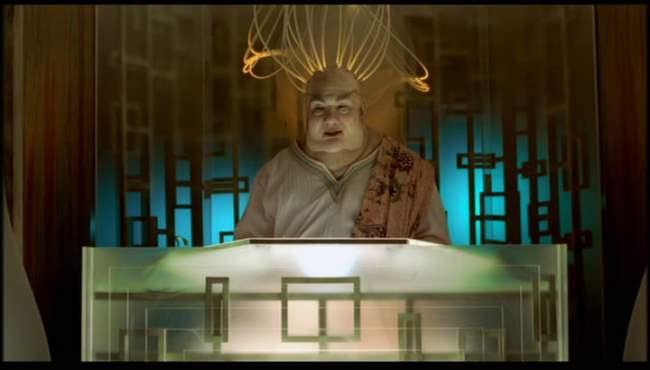
The Bottom Line: If you watch this film as I did – whereby I was expecting your typical, low-budget sci-fi action romp – then you might be pleasantly surprised. Though not that greatly. ‘Avatar’ is a film possibly best suited to die-hard sci-fi fans with no sense of taste (like moi) and who are easily impressed by a few interesting ideas and flashy set pieces (also like moi). Otherwise, steer clear and stick to the bane of ‘thinking-man’s science fiction’ (yes, I am referring to ‘The Matrix’ sequels). ‘Avatar’ has plenty of ideas, though permitting it any more than six stars would be a crime and an insult. The bottom line: CONSUME AT YOUR OWN RISK.
Movie Review By: SFAM
Year: 2006
Directed by: Warren Amerman
Written by: Warren Amerman & Marty Langford
IMDB Reference
Degree of Cyberpunk Visuals: Low
Correlation to Cyberpunk Themes: Medium
Key Cast Members:
- Magdalena: Amy Shelton-White
- Jim: Robert Weingartner
- Arthur: Sanjiban Sellew
- Andrew: David Joseph
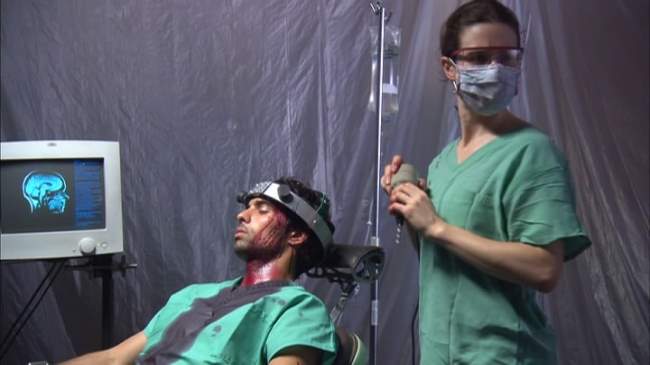
Overview: Rarely do we find low-budget horror movies aspiring to be as intelligent and ambitious as Magdalena’s Brain. Reportedly shot on a shoestring budget of $25 - $30K, Magdalena’s Brain is a professional looking film with some interesting man-machine interface ideas. To limit costs, most of the movie takes place in a single warehouse setting. Unfortunately, this psychological horror is probably a bit too slow for most, and doesn’t have enough gore for the average horror fan (although there are a few good freak-out scenes). But if you do stick with it, you get treated to a fascinating ending twist.
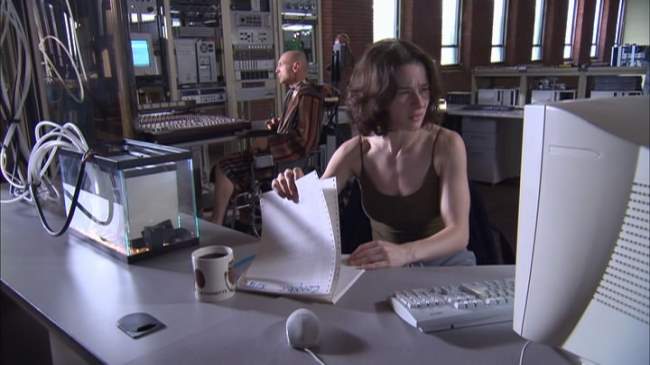
The Story: Former brain surgeon, Magdalena (played wonderfully by Amy Shelton-White) is now a reclusive alcoholic, living in a warehouse, who continually changes out shrinks in the hopes of gaining some semblance of peace. Four years after a tragic accident that left her brilliant husband-scientist, Arthur (Sanjiban Sellew) a quadriplegic and their research in tatters, Magdalena has persevered in the fleeting hopes that things will improve. Magdalena has designed an implant that allows computer-assisted dialogue with her husband. With communication restored, they have been able to continue their research in developing a synthetic brain that processes information 1000 time faster than humans. While the last four years have been slow going, recent advances have shown promise. Currently a blank slate, the organic, crystalline brain structure appears ready memories implanting. Andrew (David Joseph), a love struck former patient of Magdalena (he has inoperable brain cancer), seems to be an obvious test subject, as he will do anything to win over Magdalena.

Magdalena reluctantly takes Arthur’s advice and accepts the help of her creepy brother, Jim (Robert Weingartner), in working out how to kick-start the organic crystalline brain. First, they will download Arthur’s memories into the crystalline structure, then insert the structure into Andrew’s brain, and finally they will remove the tumor. As the story continues, Magdalena becomes more unstable. As everything comes to a head, it appears as if the same issues that led to the tragic accident four years ago might be recurring.

The Pacing: The pacing in Magdalena’s Brain is problematic in places. The first half of the movie crawls at a snail’s pace. In part it’s due to the plot, but the editing decisions certainly contribute. Eventually, it picks up in the second half. The middle of the second half is really where Magdalena’s Brain hits its stride, both in plot and pacing. The movement is brisk and the scenes really tie together well. Unfortunately, the ending action sequence comes across a series of jumbled scenes (again, I’m blaming the editing here). Instead of the frantic chase, they would have been better served having their victim do the slow, bloody crawl, with Magdalena walking after while engaged in her personal struggle. The story would have worked the same either way, but the chosen course asks us to believe that a brain surgeon can’t determine if someone is dead, and that a guy who just had a hole drilled in his brain can run for his life.
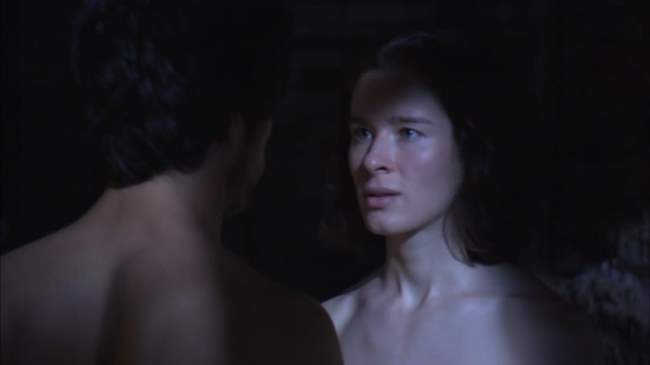
The Acting: If there’s one decision that Director Warren Amerman made that other extremely low budget film projects should consider emulating was hiring a real actor/actress to play the lead role. Even with having only a $25,000 budget, a large chunk of that went toward hiring Lost-Angeles based actress, Amy Shelton-White. Had they not done this, Magdalena’s Brain might have been a disaster. Shelton-White shines to the point that she single-handedly carries the project toward respectability, while adeptly displaying a wide range of talent and emotion. The script is problematic in places, the pacing is too slow, and the rest of the cast are role players at best, but in the end this film still works due to Shelton-White’s performance. Being in virtually every scene, she seems to bring out the best in the rest of the cast. I say this because the rest of the cast suffers when in monologue type situations, but generally hold up well when interacting with Amy. David Joseph (Andrew) in particular looks really shaky in places where he’s basically on his own, but gets lots better when interacting with Shelton-White. I haven’t seen Shelton-White in anything else, but clearly she has the chops to go places. Other the lead, the only performance with mentioning is Robert Weingartner – the “look” he generates as a creepy side-kick really worked well.
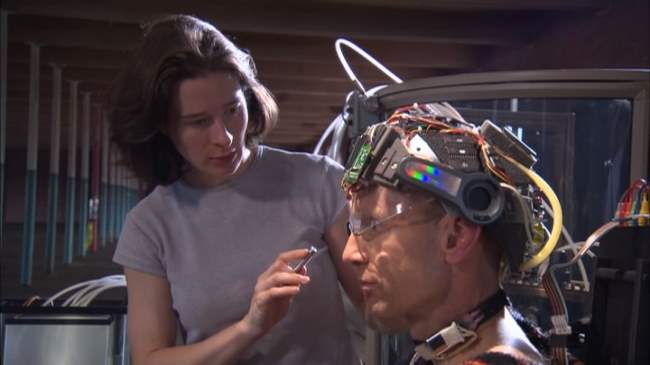
The Cinematography: Often indie films that venture into the Science Fiction genre attempt to make up for low-budget effects with innovative cinematography and lighting. This definitely is the case for Magdalena’s Brain. The use of lighting and shadow always seems to be in the forefront of Amerman’s thinking when composing a shot. Some scenes, such as the bowling scene, really don’t seem to have a place in the film from a story standpoint, but are probably left there due to the wonderful lighting and composition. Throughout the film Amerman is able to take a truly dingy set and come up with some wonderful shots. Also interesting is the lighting and sound choices for the flashbacks, although the horror shots have a cheesy low-budget feel to them. This, along with Shelton-White’s performance is able to help get the viewer through some of the pacing and editing issues.
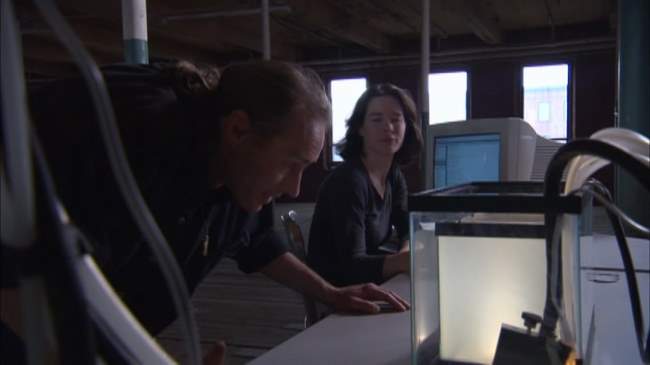
Problems With Organic Brain Design: Magdalena’s Brain uses a different approach toward creating AI. Instead of building a set of programs that mimic some trait of humanity (referred to as the “brute force method), they attempt to replicate the operations of a brain. Through the creation of a “crystalline lattice work in a gel suspension” – the thought is to create a structure that supports the firing of electrodes in a way that allows it to build its own pathways and connections. This part of the techy “mumbo jumbo” was wonderfully thought out, sparking interesting thoughts on how one might go about connecting such a “blank slate” learning structure artificial senses so that it might interact with the outside environment. One can imagine that a structure such as this, once connected to sensory input could grow at an impressive rate
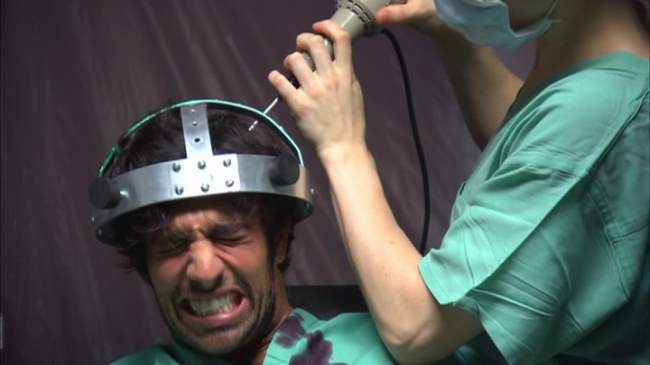
Unfortunately, this is where their science falls apart. They “solve” the blank slate problem by simply “downloading” Arthur’s memories into the crystalline brain. Worse, the brain will apparently make its own pathways using a “first-come, first-served” method of storage. Not only does this approach smack of a “miracle occurs here” scaffold, it also removes most of the innovativeness of the crystalline brain learning structure – as opposed to the pathways being organically grown based on ongoing input from its environment, they simply load a bundle of memories (which are apparently discrete chunks of data) up in sequential fashion. In doing so, they seem to be valuing the mass-storage view of the brain while discounting the interconnectedness of the pathways and concepts. This wouldn’t be too much of a problem accept that their synthetic brain seems based on creating its own connections based on organic growth.
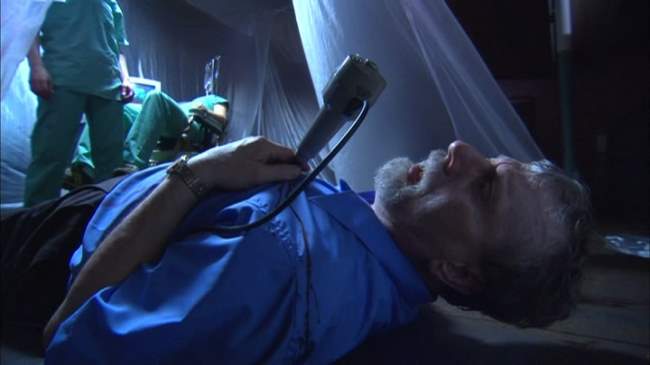
Integration of Synthetic Processing Structures with Human Brains: The most interesting cyberpunk thought in Magdalena’s Brain involves integrating synthetic processing structures with human brains. In the movie, the integrated structure will already have a sentient presence in it (see the downloading memories part above). This is an interesting approach toward building a cyborg with synthetic thinking capabilities, and is a somewhat different approach from say, the Ghost in the Shell method of increasing human capacity. In the GITS Cyborg model, computers are essentially integrated into the human mind, almost as a huge memory bank. The action thinking and decision making largely remain with the human portion of the brain (there are also fully AI processors like the Puppet Master, but they aren’t cyborgs). In the Magdalena’s Brain approach toward cyborgs, one wonders what happens when the two brain structures (synthetic and natural) occupy the same body – will they work in harmony; will one dominate the other; or will a type of schizophrenia emerge? This is all the more interesting when transposed against the psychological struggle Magdalena is undergoing.
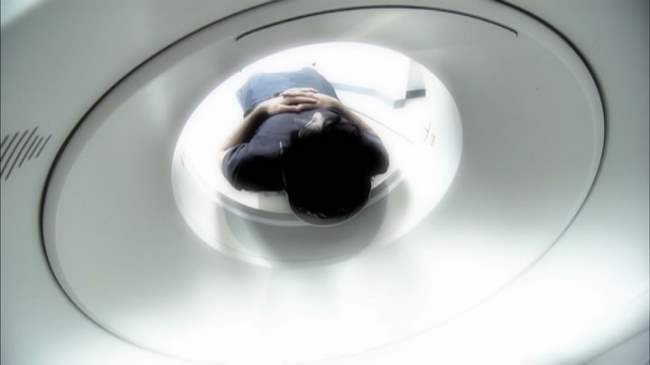
Is Magdalena’s Brain Cyberpunk? Magdalena’s Brain is one of those movies that I think barely makes it into the genre. It takes place in the present, not near future (at least that we can tell), and has no connections to evil corporations. Nor does it have much in the way of cyberpunk visuals. It does however have negative impact of technology down in spades, and an interesting take on the fusion of man and machine. For these reasons, I’ve decided to include it, but just barely.
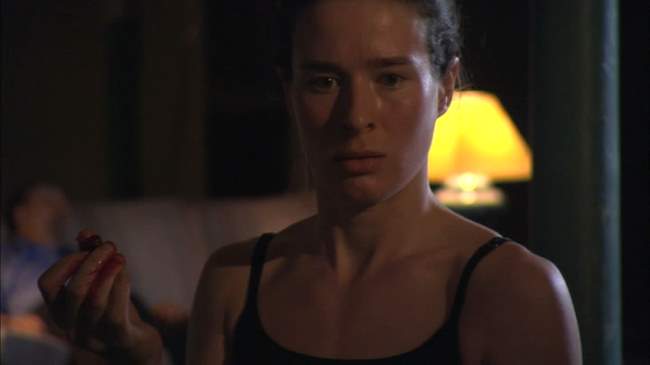
The Bottom Line: Magdalena’s Brain puts forward a terrific production considering the virtually non-existent budget. It’s very difficult to do a convincing science fiction movie on that type of shoot. I would like discuss the psychological horror aspect of Magdalena’s Brain, but won’t for fear of ruining the ending. The high points are definitely Amy Shelton-White’s performance, and a good number of some well-shot scenes. The audio FX are also worth mentioning, but the score doesn’t always fit. That said, the pacing issues will significantly reduce the potential market for Magdalena’s Brain, as most horror (and many cyberpunk) fans won’t stick with it long enough to get to the fast-paced ending. While it certainly has its problems, Magdalena’s Brain gets a passing grade. There is enough here for indie fans to give it a go, and enough of a jolt at the end that many horror fans will enjoy as well.
Movie Review By: SFAM
Directed by: Michael Winterbottom
Written by: Frank Cottrell Boyce
IMDB Reference
Degree of Cyberpunk Visuals: Low
Correlation to Cyberpunk Themes: High
Key Cast Members:
William Geld: Tim Robbins
Maria Gonzales: Samantha Morton
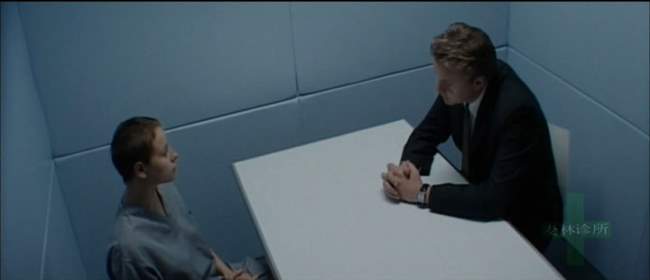
Overview: Code 46 is a movie that generates significant disagreement on ratings. The pacing is glacially slow, but there are enough interesting ideas that many viewers will really dig the final product. Viruses as transhuman upgrades, memory removal, and problems brought on by mass cloning all are mashed together to give an interesting, but somewhat incoherent view of a near-term dystopic future. The cinematography is interesting, and the story itself may end up working well enough for some to enjoy the final product.
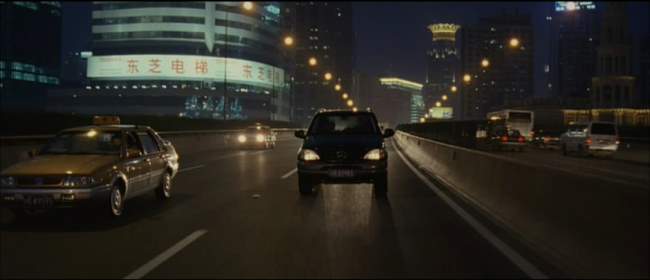
The Setting: Code 46 takes place in a non-specific near future, where overpopulation and degradation of the earth have led to a situation where cities have become protected entities. The population is now divided into those living in the outside and those citizens who have rights to live within. Each city has restricted access – a person is required to have “papelles” (a valid passport/visa) to enter. For some reason, even though there is massive overpopulation, cloning has been used in an overabundant fashion. There is even a law, Code 46, which restricts the relations between those who are genetically similar. Viruses have been genetically engineered to allow new capabilities for people, but also have become so deadly that people must have a valid insurance policy to stay in the city.
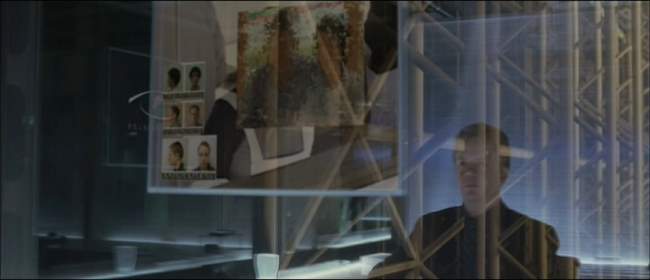
The Story: William Geld, played by Time Robbins, is an insurance investigator imbued with an empathy virus, who’s been tasked to track down a forged papelle ring in Shanghai. Shortly after arriving, William quickly determines that the guilty party is a worker named Maria Gonzales (Samantha Morton), but he doesn’t turn her in. For some reason, even though he is happily married, he is strangely attracted to Maria, so he falsely implicates someone else. After following her home, Maria and William become fall for one another. William leaves the next day for home, but is brought back a few weeks later when the forged papelles continue to be produced. He decides to turn Maria in, but she has left. After investigating, he finds that she had incurred a code 46 violation. William fears that he is the genetically similar party and sets off to find her.
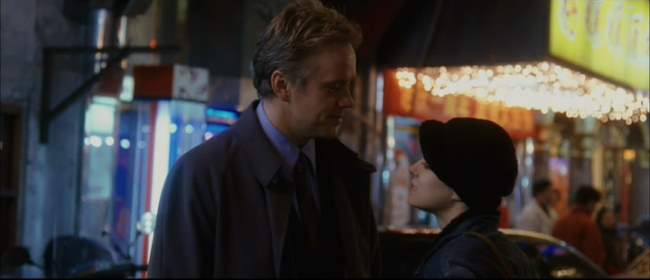
The Acting: Director Michael Winterbottom seems to be going for a Lost in Translation type vibe, but this feel doesn’t really work very well. The leads both turn in believable performances, but something is missing. While the world certainly has an alienated feel, there’s never a sense that the chemistry William and Samantha is strong enough to support a “genetic attraction.” It’s all cerebral. Unfortunately, with the rediculously slow pacing of the movie, this merely adds disconnectedness with the audience.
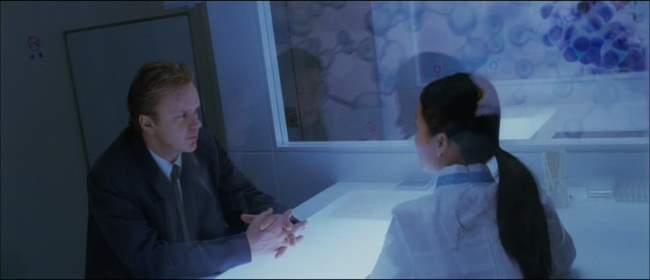
Viruses as Genetic Upgrades: In Code 46, custom made viruses are used for short to long term sensory upgrades. William has an “empathy” virus which allows him to read people’s thoughts. Other viruses allow skills to be developed. The weird thing about the use of viruses as an idea for genetic manipulation is that it causes all sorts of dangerous linkages. For instance, viruses can be passed on, and worse, can change over time. This, I think, is why insurance may play such a large role in Code 46, and why the cities are cordoned off (again, this isn’t really explored all that well). It does make you wonder though, how exactly will genetic manipulation be used in the future? If we are to look for transhuman-like upgrades, are we going to be purchasing an ensemble of cocktail viruses?

Futuristic Low-budget Worldbuilding: Without a large budget, and the absence of CG, director Winterbottom struggles to make his world look futuristic. Mostly based on locations, Winterbottom also emphasizes pastel florescent shades to indicate futurism. Pastel florescent pinks, greens, and blue tones are used in most of the otherwise normal looking city scenes. The outside world is mostly desert, apparently brought on by the effects of global warming, whereas the people all dress like they’re in New Dehli. The night scenes are generally neon shots of Shanghai, which sort of fit in the cyberpunk, near-future genre. Still, there are glaring problems which break suspension of disbelief, where the futuristic world looks identical in most places. The most obvious one deals with the liberal use of modern day cars - apparently the auto industry got laid off after 2003. A cheap solution would have been to jimmy up a few futuristic fiberglass bodies to stick on-top of a jeep or VW, but instead, we are almost left with an alternate view of the present.
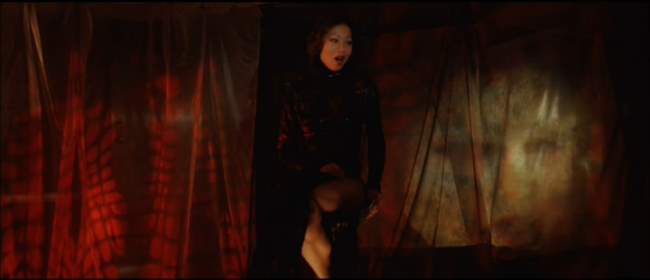
Cyberpunk Tower of Babel – the Creole Merging of Languages: In Code 46, English seems to be the only language used, but it has been “creoled” in that many of the words have been replaced with words from other languages. Boy and girl is now chico and chica; paper is now papelle; hello has been transformed to “meehow”; discontinued is now discontinuago. The cool part about this is how naturally the actors work the word changes into the dialogue. The problematic part of this is that within 50 years or less, the world (even if only the industrial parts) would transform into a single language. If there even is a trend toward this, I think we’d be looking more like 300-500 years for a place like Shanghai to do away with their native Chinese. The more interesting question this raises though is the issue of whether the human race is moving toward a reverse Tower of Babel, or whether the local cultures will become more entrenched as a defense against a globalized language and culture. The world is getting smaller all the time – the implications of this are far from understood right now.

Cyberpunk Oedipus Complex: Harkening back to Freud, Code 46 explores the issue of a man in love with his mother. In Code 46, this connection is so strong that it exists even when the relationship itself is not known to the participants. Personally, I never bought into anything as generalized as Freud’s Oedipus complex, and I don’t know that it works all that well here. But the genetic/cloning slant to this question certainly raises some interesting thoughts. Still, with the advent of overpopulation, its hard to see why people would resort to making an abundance of clones. Perhaps for nefarious thoughts such as body replacement parts, but it would be a stretch for an overpopulated world to create massive versions of the same person. Based on the huge insurance slant in Code 46, we might assume it had something to do with contaminated bodies, but like so many other aspects of this future world, this is never really explained.
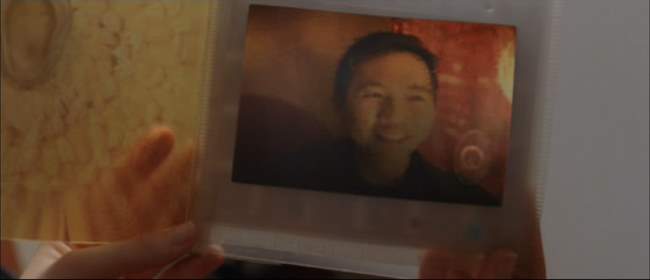
Removal of Memories: The idea of memory modification and their removal has been explored in other movies (Eternal Sunshine of the Spotless Mind, for instance), but the general question is probably similar. Are memories discrete entities that can be targeted and wiped out, or is something more organic going on? Also, if your spouse cheats on you, will a future option for conflict resolution be to simply have the memories of the offending person and the deed itself removed? If so, would you still think your spouse cheated?

The Bottom Line: Although the plot runs at a glacial pace, and the chemistry between the actors is stilted at best, the inclusion of interesting thoughts, however haphazard, potentially make Code 46 worth a watch. I would have liked to see a bit more clarity on the basis for the technology selections, and definitely would have liked to see more emotive chemistry between the leads. The “Lost in Translation” vibe just doesn’t work here all that well. Bottom line, if you’re someone who doesn’t mind watching interesting looking paint dry, you might end up liking Code 46.
~See movies similar to this one~
Movie Review By: SFAM
Year: 1962
Directed by: Wesley Barry
Written by: Jay Simms
IMDB Reference
Degree of Cyberpunk Visuals: Low
Correlation to Cyberpunk Themes: Very High
Key Cast Members:
Capt. Kenneth Cragis: Don Megowan
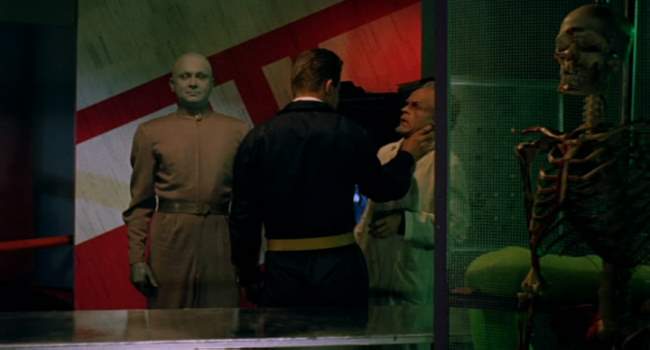
Overview: It’s a rare instance when we find a movie that has all the trappings of a “B” SciFi shlock-fest – one with an overly cheesy name, a DVD cover advertising the movie as a classic drive-in flick (as was the original marketing art), one which has the standard “B” movie high-pitched moaning female chanting alien vocal track duing the credits and a creature-feature font typeface for its title – but in fact isn’t. Creature of the Humanoids practically screams “low-budget, exploitative SciFi crapfest” but…isn’t. Instead, after digging beneath the voluminous trappings of “B” cinema, we find a very intelligent, but low-budget movie – one which in 1962 has captured a good number of the cyberpunk themes that would dominate literature and movies twenty years later. Contrary to the DVD cover, which combines Creation of the Humans with War Between the Planets (which is pretty much what you think it is), this is a slow-paced, thinking person’s movie. Said another way, I’d probably be damn bugged if I had taken a date to see this at a drive-in, but as an intelligent movie for CyberpunkReview, it works fine.
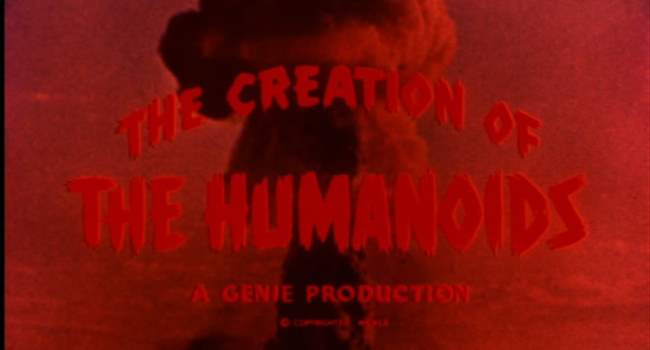
The Setting: A nuclear war has taken place, resulting in the extermination of 92% of the human race. Those that remain are riddled with radiation poisoning, leaving very few couples who can create viable offspring. To keep civilization running, the remaining humans significantly ramped up their production of robots, which now number almost a billion in total, and handle most of the mundane tasks of society. Over time, advances in AI and automation have created a “race” of robots that have become sentient, and even more capable than their human counterparts. Because humans couldn’t stand working next to machine-looking things that seemed smarter than them, robots began being constructed to emulate humans. Now, 20% of all robots look humanoid in nature. However a backlash has formed - a hate group called the “Order of Flash and Blood” is pushing for the ban on all humanoid-looking robots. Because of a backlash by many humans, these robots can only look 70% similar to humans.
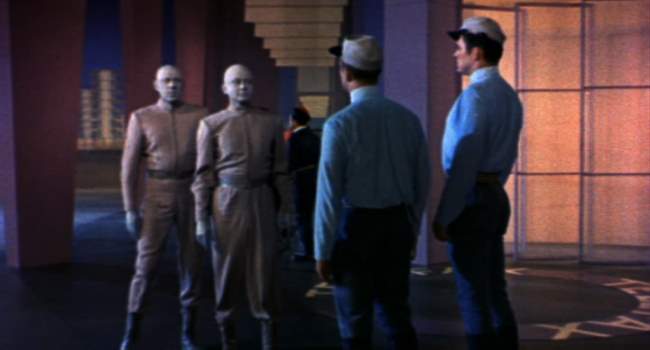
The Story: Capt. Kenneth Cragis (Don Megowan) is a leader in the Order of Flesh and Blood, the robot hate group. While on monitoring the activity of “clickers,” a derogatory term for robots, he notices some suspicious activity entering the robot shrine, a building off-limits to humans, which contains the central AI program that most robots now take direction from, and practically worship. In getting Flesh and Blood members to storm the shrine, they find a robot that looks almost fully human (96%) who has just killed a rogue scientist. As robots are all programmed to follow what essentially are Asimov’s three laws of robotics, this constitutes the first instance of a robot killing a human. Cragis sees this as an opportunity for the order to finally break-through and convince the human leadership of the righteousness of their cause. But in analyzing the human-looking robot, they discover something horrifying – it turns out that this robot actually “thought” he was a person, and appeared to have been created by taking the essence of a person recently dead, and replicating them inside of a robot.
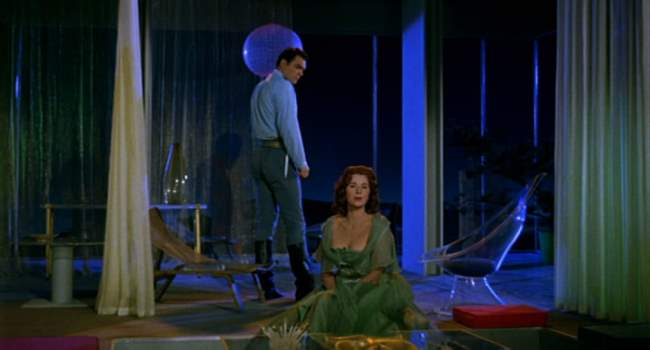
Cragis also has another dilemma, his position in the order is now threatened, as its come to light that his sister has recently entered “rapport” with a robot named Pax. When in rapport, the robot and human essentially share the same mindset – everything his sister desires is instantly understood by the Pax and her needs are met. They are essentially soul mates. Cragis and his sister are on complete opposite sides of this issue, and there is no way for him to convince her otherwise. But things go from worse to weird when Cragis, and his newly found love (Erica Elliott) discover a truth about themselves that will shake the foundations of humanity.
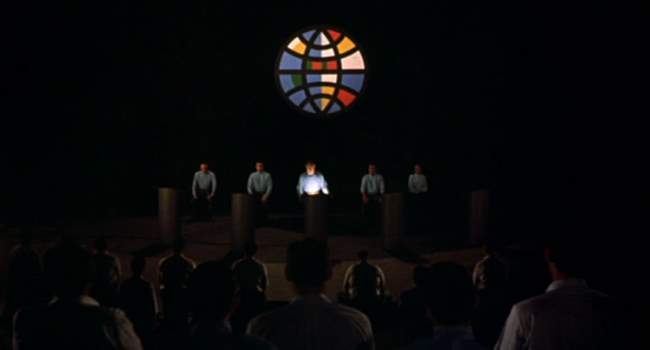
The Production Values Suck: If I were grading Creation of the Humanoids based on production values alone it would be grateful to achieve even a three-star rating. From a production value standpoint, this movie is poorly made. The very few sets that exist look like warehouse sets quickly done up with extra junk from other SciFi movies and the only music accompaniment used everywhere (including love scenes) is the eerie “alien ship is coming” sound. The FX, especially of the robots are very poor, consisting primarily of bald-hair pieces and green makeup. Aside for a few of the leads (Don Megowan, the most important character is decent) is sub par at best. From a production value standpoint, Creation of the Humanoids seems far better suited to a play than a movie. If fact, I wouldn’t be at all surprised if this was the original intention of Jay Simms’ script. The DVD treatment, which provides a far better than expected transfer, essentially tries to mimic a drive-in movie experience. This is annoying it that there is no chapter feature. You are forced to click through the upfront stuff, the first feature, and the intermission crap to even get to Creature of the Humanoids.
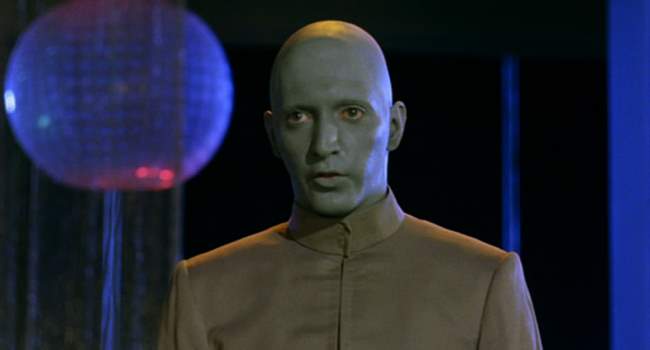
If a Man Loses His Leg, Is His Soul Affected? this is the question posed by Creation of the Humanoids. If one answers that the soul is not affected, the follow-on thought is what if the whole body was replaced but that the essence that is “you” survives in an android shell. Do you still have a soul? If not, when did you lose it? Creation of the Humanoids provides us a world where humans are quickly becoming extinct, and where their salvation is going to be a situation where their personalities – all that makes them unique – are transferred into robotic bodies. They even will still be able to procreate, after a fashion. So the larger question this movie finally poses is: in this completely post-human world, does humanity still exist?
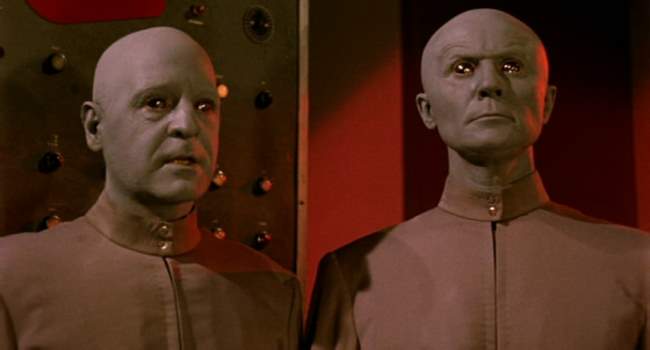
Replicants in Years Past: While Blade Runner is most often credited as having the definitive replicants, clearly this idea has been around for a lot longer. In Creation of the Humanoids, robots that are 96% human capability are created by taking a recently diseased person (within six hours of death) and extracting all that is unique about them (their memories, learning, skills, philosophy, etc.) and inserting it into a special thalamus chip to be integrated into a robot’s cerebral cortex processing unit. In doing so, they wipe all memory of the human’s last moments (their deaths). The end result are robots that still think they are human. For all times other than between 4:00 – 5:00 am, the robots act completely human. But during that one hour, they remember who they really are and report back to the robot society.
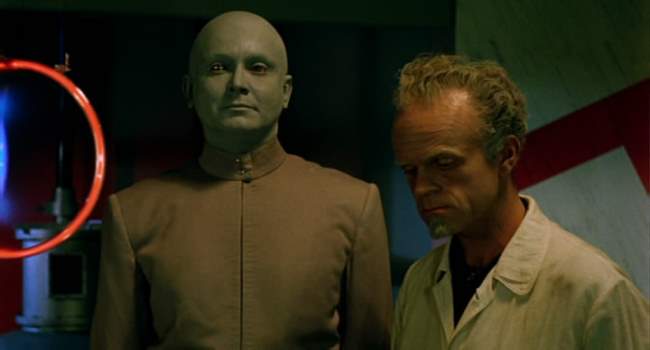
Asimov’s Laws Were Already Being Followed By 1962: Creation of the Humanoids gives us a glimpse of the incredible influence that Asimov’s “I, Robot” a mere 12 years later. The Robots in this already adhere to the laws, and have already worked out methods to break them. Robots must never harm other humans, and must always work to serve their best interests. Yet, unfortunately, humans don’t always know what is in their best interests, and thus, the robots must become subversive to meet this law.
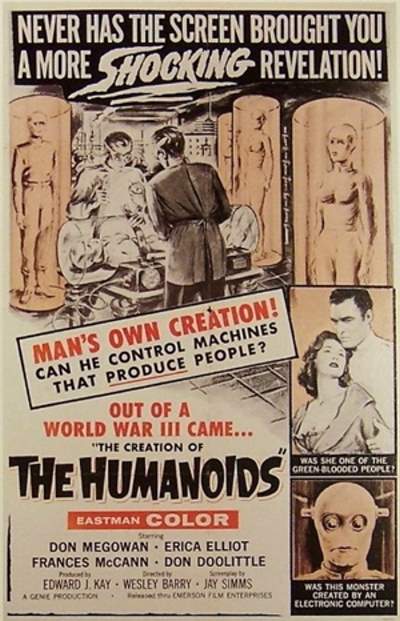
Clearly, this movie was created and marketed as a creature-feature. One can only imagine the disgust that writer Jay Simms had to this bastardization of his overly thoughtful script.
When Robots Control Humanity: One of the more interesting arguments Creation of the Humanoids engages in is the question of what life will be like if and when the robots control mankind. In this movie, the robots have already gained control of who is in gets elected, even though the regular populace has no clue this has occurred. The robots also engage in subtle methods of mind control and brainwashing, all to make the populace more accepting of robot rule. Because the robots believe humans do things not in their best interests, it becomes their duty to “manage” human life. The question is then raised whether humanity will still want to pursue knowledge and self-betterment – after all, what’s the point if everything you even think you might want is automatically provided for you? The answer is rather depressing here – it has already happened – that we’ve just now realized it is almost irrelevant.
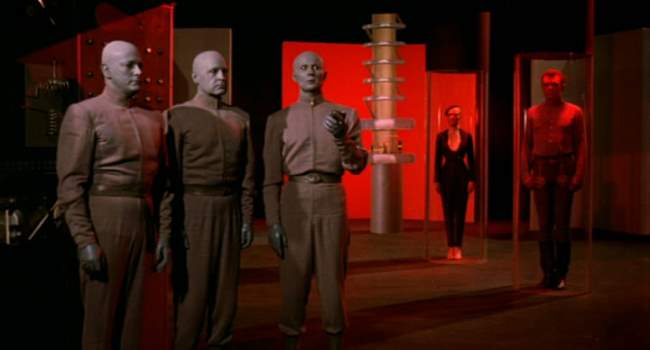
The Bottom Line: While the production values suck, the story in Creation of Humanoids is both complex and interesting. Many ideas presented are wonderful grist for later books and movies. As long as you realize that the production values in this flick make the old Dr. Who series look high-tech, you’ll probably enjoy it. While it is very slow-paced and only has about 5 separate scenes, the ideas presented are interesting enough to keep your attention. Aside for the commentary on race relations (obviously a big issue in the early 60s) Creature of the Humanoids makes us think through some interesting notions of post-humanity. While I’d give it 3 stars for its production values, I’d give it an 8 star rating for its story. This won’t appeal to everyone, but is certainly good enough that it shouldn’t be forgotten.
~See movies similar to this one~
Movie Review By: SFAM
Year: 1997
Directed by: Jean-Pierre Jeunet
Written by: Joss Whedon
IMDB Reference
Degree of Cyberpunk Visuals: Medium
Correlation to Cyberpunk Themes: Medium
Key Cast Members:
Ellen Ripley: Sigourney Weaver
Annalee Call: Winona Ryder
Dr. Jonathan Gediman: Brad Dourif
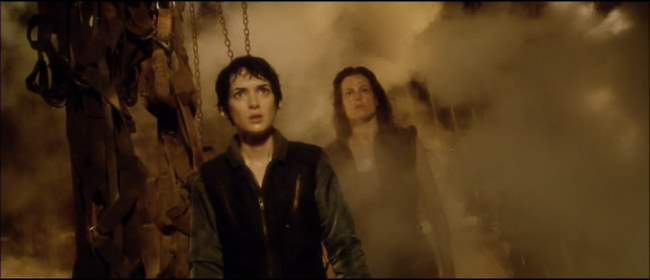
Overview: While Alien 1 and 2 were both stellar movies, the later two sequels definite suffer in comparison. Still, Alien Resurrection provides a significantly different Ripley than is encountered in the first three movies. Ripley is a clone, and an altered one at that. In fact she’s a merging of both the alien and human. With a significantly different approach to visuals and storytelling, Alien Resurrection may not equal the quality of the first two, but certainly can be considered original, which is sometimes a feat in itself for a sequel. The cyberpunk elements, while present, are still sedated, similar to the first Alien (I don’t really consider Alien 2 or 3 to have enough to consider them cyberpunk).
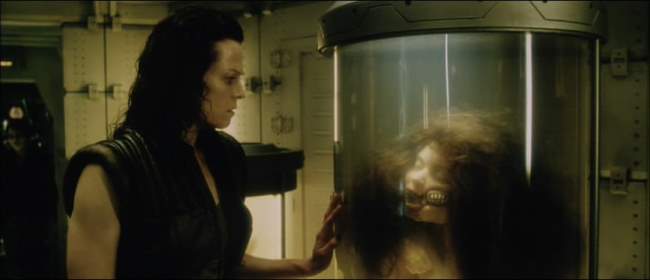
The Story: Two hundred years after her death, Ripley (Sigourney Weaver) has been cloned for the purpose of giving birth to the Alien Queen inside of her at the end of Alien 3. It’s not the corporation this time, instead it’s the good ‘ole government. While it’s never really fully explained how the melding of the two came about, you basically have to “roll” with it if you want to enjoy the movie. In any event, Ripley somehow survives the birth of the Alien, and is kept alive for “study” purposes.
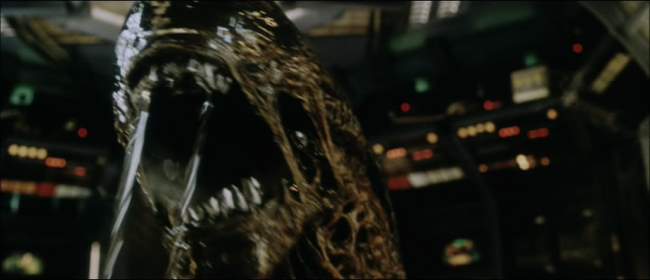
Meanwhile, the Alien Queen that Ripley births requires hosts for her eggs. Enter a group of mercenaries led by Elgyn (Michael Wincott). His group also includes Winona Ryder, Dominique Pinon, Ron Perlman, Gary Dourdan, and Kim Flowers. The mercenaries have captured a ship full of people in suspended animation, and have brought the victims to the military research ship for money and other goodies (including a few days sleep in a regular bed). Things go bad when fanatatical crazed head scientist, Dr. Jonathan Gediman (Brad Dourif) makes the mistake of leaving three of the Alien births in the same cage. Two of the aliens kill the third, who’s acidic innards then create a hole in the floor, thus forming a jail break. From there, its on – aliens are in control and have a field day in eating up the poor humans who can’t escape on time. But unfortunately for the Queen, her DNA has been melded with Ripley’s and her second generation offspring has turned out differently than intended.
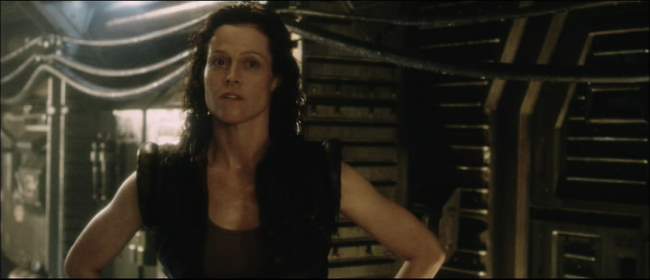
Ripley is Different in Resurrection: In Resurrection, we don’t get the tired, beaten down Ripley from the previous two movies who somehow manages to persevere and survive. Instead, Weaver takes to her genetic change with a gusto that mixes just the right mix of alien swagger, camp, and tender humanity. Most importantly, Weaver doesn’t take herself too seriously here. Ripley’s smirks more than anything else make the impossible set-up bearable. Its almost as if she’s saying, “Yeah, this is Frankenstein 4, but you knew the monster (me) needed to come back from the dead if there was to be a sequel, right? Just roll with it and we’ll be OK.” In short, Weaver almost single-handedly makes this sequel work. Ripley’s one liners (such as, “Who do I have to fuck to get off this ship?”) sometimes even come close to equaling those in Aliens. However, this approach can only go so far - if they ever plan on doing an Alien 5, they’re gonna need to revive Abbot and Costello!
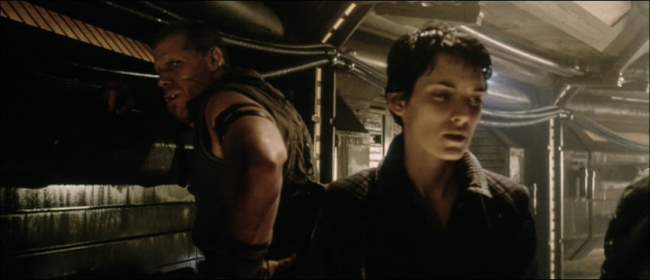
The Rest of the Cast: While Weaver shines, the same cannot be said of the rest of the cast. Some of the member are really hit or miss, while others fail altogether. Winona Ryder’s role was a bit too much for her to pull off. First she had to be a believable mechanic (Kaylee, she’s not!), and then had to be an undercover resistance member and finally had to work as a {SPOILER – highlight to read} second generation android. I don’t know who could have worked all three of these aspects into a coherent whole, but Ryder was not able to pull it off. Although, Ryder does shine in some of the scenes – especially those that are similar to Ripley’s role in the first movie where the Ryder is struggling to maintain sanity when everything is stacked against them. For other examples, Brad Dourif as the crazed scientist is too over the top, and Dan Hadaya as the military commander comes off as a complete imbecile. Two notable standouts are mercenaries Ron Perlman and David St. James – both turn in very solid and interesting performances.
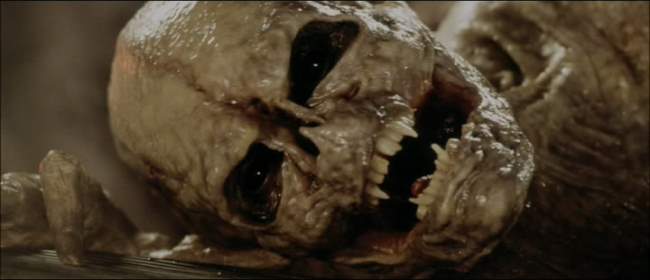
The DNA Mixing: OK, the DNA mixing explanation is just too hokey to work. Joss Whedon deserves some credit for at least not running away from this impossible task – instead he makes it a centerpiece to the story (but it still doesn’t’ work – then again, I don’t think anything would). Basically they needed a way of both recreating Ripley will still keeping her memories intact. Their work-around is to state that Ripley’s and the Alien’s DNAs melded together (I suppose this happened in the lava? Good thing they were able to retrieve it, ey?). OK, fine, but I have a few questions: Aliens are uniquely different from humans but their DNA is so close that its not distinguishable form one another? Or assuming the DNA was melded, how exactly did they know what they were looking at? More to the point, how did they figure out (even with lots of trial and error) to make two completely separate organisms out of the DNA? But even taking the ocean of salt needed to buy that explanation, how is it that an alien organism who grows by eating the material in the lungs is able to read Ripley’s memories and retain them? Again, while this clearly is problematic, you really just have to roll with it if you want to enjoy Resurrection.
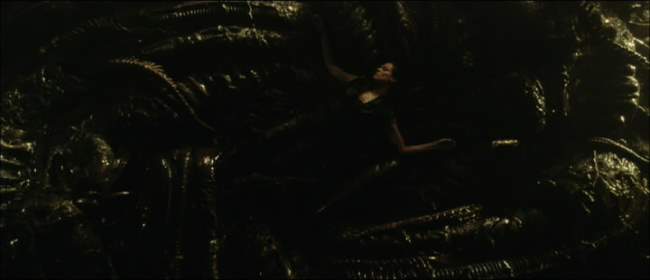
Genetic Manipulation Scare: Probably the scariest aspect of Alien Resurrection is the notion that in the semi-near future, genetics will be advanced enough and so well understood that even your basic crackpot scientists with the right equipment can play Josef Mengele in experimenting with mixing lifeforms to their hearts content. One can imagine a number of variations to this, but the jist of the concern is that its not too far a stretch to imagine that in the near future, less savory governments or corporations may be lured to do various genetic trials of this kind in the pursuit of fame and profit. This concept in Resurrection is as cyberpunk as one can get.
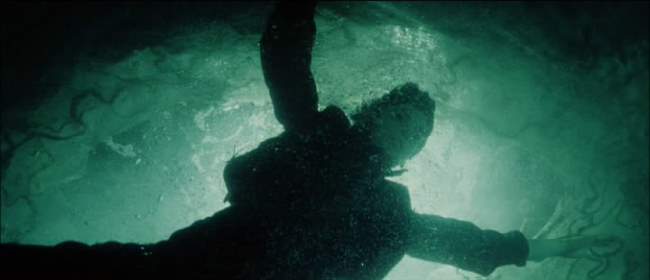
The Android: Unfortunately the back story is glossed over, but in Alien Resurrection, the androids have somehow developed a second generation android, one who is not beholden to human command. Not surprisingly humanity targeted them for termination, which caused the remaining second generation androids to burn out their communications devices and go into hiding. In Alien Resurrection, it’s the android who holds the tenets of humanity most dear. The android is more concerned with the fate of mankind than all the shallow and flawed humans in this movie. The android is even religious. One wishes this aspect of the androids was explored. If they truly feel that they indeed have a purpose for existence, how is this rationalized, and how have they changed the concept of a human deity to accommodate their self-worth?
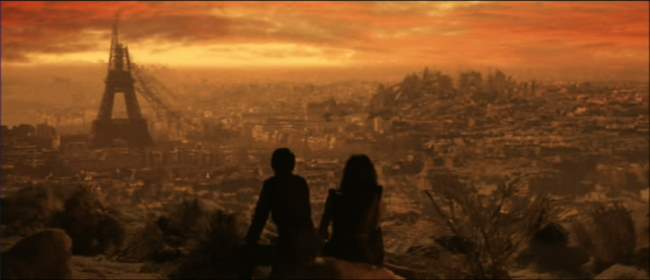
The Visuals: Director Jeunet and visual effects supervisor Pitof deserve credit for creating some wonderful visuals in Alien Resurrection. Resurrection contintually treats us to some wonderfully composed shots – shots that far exceed the qualities of the acting. Even if the plot and acting turn you off, the cinematography, wonderful set pieces, models and creature FX will help keep Alien Resurrection bearable. Like many cyberpunk films, a single color dominates the film – yellow in this case. Yes there are some blacks, but yellow seems to permeate all the key scenes.
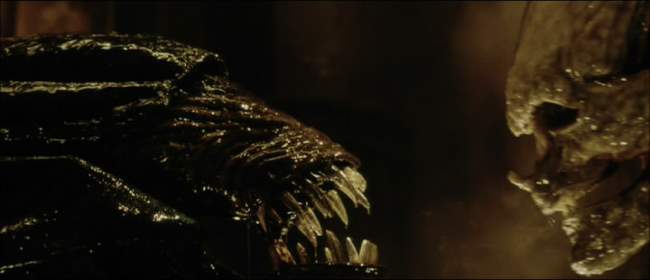
The Bottom Line: Yes, Alien Resurrection has an extremely problematic story within a flawed movie, but it ends up being more fun than it probably deserves. Even though the rest of the cast doesn’t always support her, Sigourney Weaver turns in a terrific performance. This, along with the originality, the wonderful cinematography and FX make Alien Resurrections a step up from Alien 3, and worthy enough to watch. While the cyberpunk elements are subdued, the android along with the genetics and dystopic civilization (destroyed by human wastes and technology) are enough to include it in this site. Alien Resurrection won’t flip your world like the first two did, but its still worth a watch.
~See movies similar to this one~
Movie Review By: SFAM
Year: 2005
Directed by: Karyn Kusama
Written by: Phil Hay & Matt Manfredi
IMDB Reference
Degree of Cyberpunk Visuals: High
Correlation to Cyberpunk Themes: Medium
Key Cast Members:
Aeon Flux: Charlize Theron
Trevor Goodchild: Marton Csokas
Oren Goodchild: Jonny Lee Miller
Sithandra: Sophie Okonedo
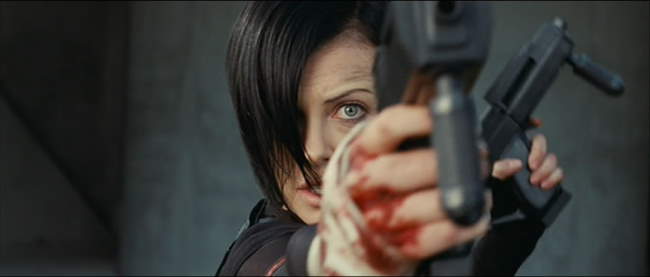
Overview: In the best of cases, remakes of cherished shows rarely turn out good. The MTV Aeon Flux cartoon series was an intensely creative post-modern show by Peter Chung, who broke all the rules of how narratives are supposed to be told. The lead character, Aeon Flux, the ultimate anti-heroine, dies on a regular basis; nobody was purely evil or purely good; and everything was high-tech body modification chaos. Unfortunately, the movie does away with all that. In an attempt to “humanize” the iconic figure of Aeon Flux, the movie version goes for a standard rebels-versus-Orwellian bad guys movie with a twist. While some of the visuals are absolutely terrific (including some wonderful action scenes by Charlize Theron), in the end, this is a very different story with very different characters, and must be understood as such.
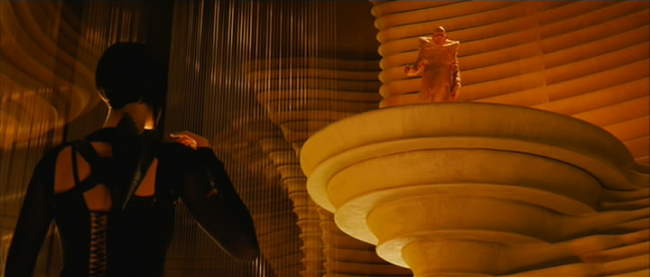
The Story: Aeon Flux takes place 400 years after a virus has devastated humanity, killing off 99% of the population. Now, one walled city named Bregna, holding 5 million people is all that remains of humanity. Bregna is ruled by a council of genetic scientists who have (supposedly) been avidly working on fixing the fallout of the virus for the past 400 years. For reasons only partially explained later in the story, the ruling council has instituted a totalitarian government with an extreme crackdown on personal freedoms, and have backed their authority with an intense surveillance apparatus. A group of rebels called the “Monicans” have challenged their right to rule, and have vowed to destroy the ruling council, especially their leader, Trevor Goodchild (Marton Csokas), at all costs.
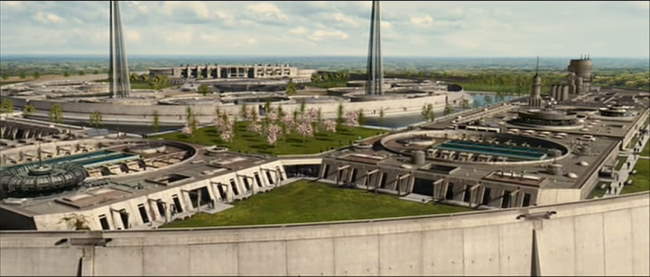
Aeon Flux (Charlize Theron) is the Monican’s very athletic, butt-kicking, black spandex wearing operator-extraordinaire. No mission is too dangerous, and no obstacle is insurmountable. In what serves as the prologue, Aeon’s last surviving family member, her sister is killed by the Bregan Council authorities – all that remains for Aeon is revenge and the mission. Finally her time comes when the fiery-haired Monican handler (Frances McDormand) authorizes her to go assassinate Trevor Goodchild. So Aeon and her partner with four hands and no feet, Sithandra (Sophie Okonedo), storm the garden and infiltrate the Brega Council compound.
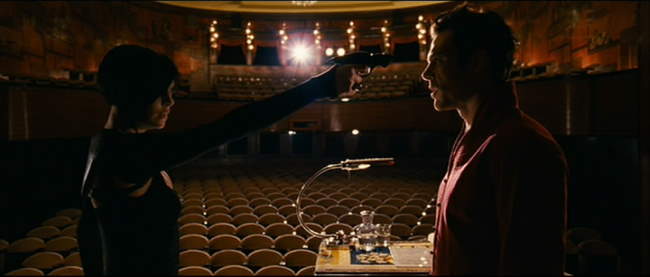
Unfortunately, as Aeon finally encounters Trevor, not all is at it seems. She suddenly has memories of kissing Trevor in a former life. Worse, it looks like there are other forces at work, and perhaps Trevor isn’t the bad guy the Monicans have made him out to be. As Aeon follows her heart and the ever expanding mystery, she engenders anger from the Monicans, while Trevor ends up at the wrong side of a coup-des-tat at the hands of his evil brother, Oren Goodchild (Jonny Lee Miller).
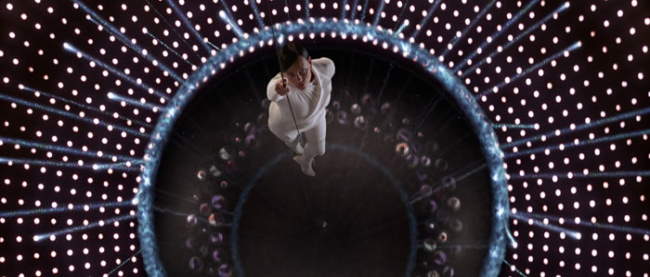
Story Problems: While the front half of the Aeon Flux story works, the back-end is riddled with inconsistencies. If you spend an ounce of time thinking through the motivations, the actions of the main bad guy make no sense. What he really wants (immortality) can be accomplished even Trevor’s experiments prove successful. This is muddied further when the Jurassic Park mantra, “Nature finds a way” is added to the mix. Even weirder is Pete Postlethwaite’s character, who comes across almost as the watcher in a Fantastic Four comic. We are never sure if he is real or Memorex. Worse, his final monologue where he explains his actions adds yet another strange element to the scifi-mix – precognition. In the end, there are too many fantasy-like technologies for this to come across as believable. In brief discussions with on the writers (Phil Hay), it appears that the original script might have been tampered with. I really hope this is the case, as the visuals of the movie were more than strong that they would work for even a passable story.
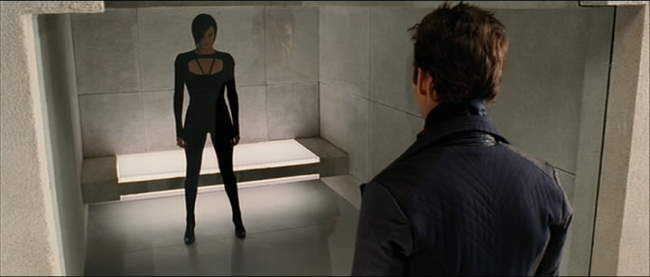
Changes With Aeon and Trevor From the Cartoon: The move version of Aeon Flux in no way matches the lead characters of Aeon Flux and Trevor. In Peter Chung’s cartoon, Aeon Flux comes across as the ultimate anti-heroine. While she clearly knows right from wrong, and generally tries to stop the worst abuses, Aeon is an ultra-acrobatic, top-notch action-espionage heroine who works for herself, and only operates under her own agenda. Trevor is a mostly malevolent, superior dictatorial character who as a true soft-spot for Aeon. For her, he will bend his approach, but otherwise he rarely is a nice guy. We rarely see fear, doubt, or self-loathing out of Aeon, although she too has an eternal love for Trevor that trumps all. Kusama’s version of Aeon and Trevor tries to humanize them, and in doing so, removes much of their uniqueness and appeal. New motivations and afflictions are created where none previously existed. Worse, their very nature changes. In the end, Trevor turns out to be a misunderstood hero who works valiantly to save humanity – his only fault is he turns a blind eye to his brother’s excesses. Aeon becomes an agent working for others goals, but only later turns to herself based on principled evaluation of what is right and wrong. Again, while both of these characters may be interesting if done well, they bare little resemblance to the mindset of the Aeon and Trevor characters from the original show.
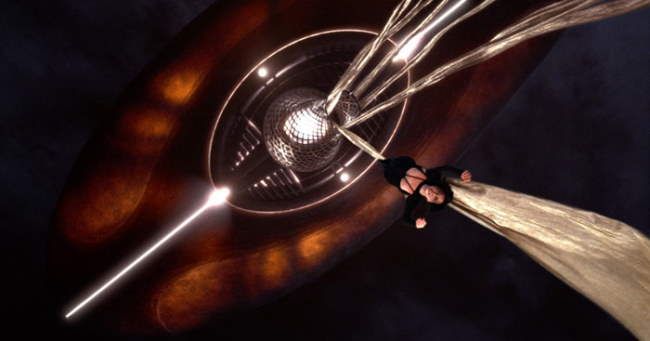
Still, I must give credit to Charlize Theron’s athletic feats in this movie. By all accounts she spent 3 months training to be a gymnast and fighter, and it shows. While for the most part she does away with the ultra skimpy clothes from the cartoon, she really does nail the gracefulness and style of the cartoon Aeon Flux. And while I don’t necessarily agree with the humanization approach, Aeon does pull this off very well, especially considering she has very little dialogue. The fact that she got seriously injured on the tenth day of shooting (herniated disc injury), but came back to continue the vast majority of the stunt work is a testament to her commitment and professionalness, and should be applauded. If I had one complaint with her protrayal, she really doesn’t really “look” the part, in that the cartoon character was a taller figure with a far more angular face and tapered hair.

Editing is Way Too Frantic: Aeon Flux was a very contemplative animated show. Almost always, you had time to properly digest a scene. The atmosphere of the original series is largely based on the pacing. In the movie version, the editing seems designed to artificially hype the tension. In the end, it results in sucking the life out of many of the scenes. You rarely have time to feel connected to the scenes. More often, you feel like you’re riding a roller coaster, even when the scene is nothing more than two people talking.

The Technologies in Aeon Flux: The body modifications (such as hands replacing feet, and various stuff stored within the skin) in Aeon Flux really added to the visual appeal. Also, there were a number of interesting technological innovations. Probably the biggest was the peer-to-peer interaction in “brain space” that the Monicans use to elude the Orwellian-style surveillance systems that the council has set up. The flat metal slices that turn into semi-autonomous exploding balls were visually cool, as was the room that worked in two dimensions (each dimension of frequency holding completely different items). I also liked the bubbling Band-Aids that Aeon has stored, hiding on her skin.
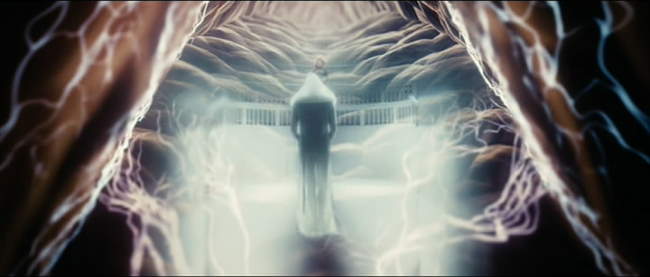
The larger technology involved cloning. In Aeon Flux, cloning equates to flawed reincarnation. With each generation the people are cloned, the memories of their lives somehow stay with their soul – yet with each time they are cloned, the new person has memories from the previous versions. Over time, the cloning ends up destroying each other’s reality. For the most part, I don’t think this idea worked all that well. It gets especially troublesome when we look at the Keeper, who seems to be able to “remember forward” and thus, make decisions 400 years ago that will help save the world well into the future.
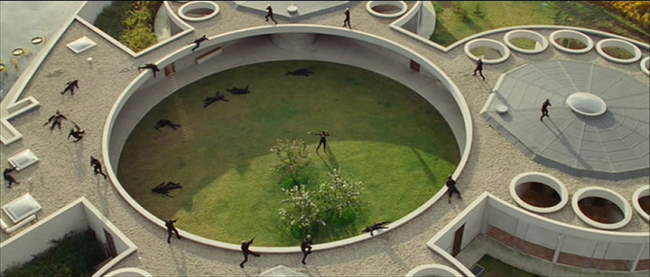
The Visuals: Visually, Aeon Flux is a gorgeous movie. We have also sorts of beautiful futuristic city settings, beautiful characters, and really fun FX. Some of the visuals are completely nonsensical though – the most egregious being an early scene involving Aeon wearing white for the ONLY time in the movie when she wants to stealthily sneak into the Brega compound at night. While this helped make Aeon’s character stand out more, it immediately brings a sense of Hollywood unreality to the whole affair. Still, while many of the action scenes didn’t make lots of sense, they were all nicely shot. Some of the fights were pretty gritty, but for the most part, the resembled a gun-version of a kung-fu dance movie.
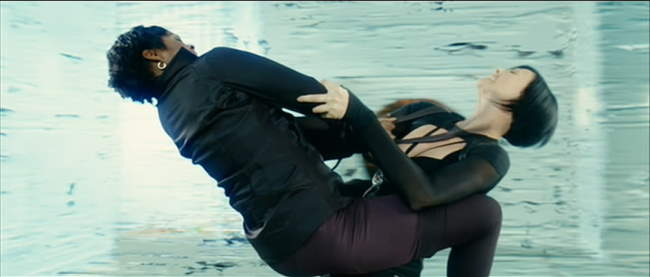
Lots of Hawt Chick Fighting! One of the better aspects of Aeon Flux involves the massive amounts of hawt chick fighting! Yes, its low-brow, but we like it. We get some really juicy fights between Aeon and Sithandra, and Aeon and Trevor’s bodyguard, Freya (Caroline Chikezie). And of course we have massive amounts of Charlize Theron in tight black spandex, kicking butt. While some have compared this aspect to Catwoman, the comparisons are unfair in that 1) we don’t have Mouseketeer ears, 2) all the fighters are very athletic, unlike Sharon Stone in Catwoman, and 3) the fight choreography is far far better.
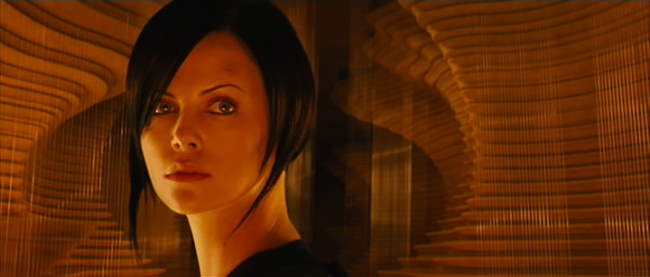
The Bottom Line: While there enough to like in Aeon Flux to give it a passing grade, I really can’t give it more than that. A movie version of Aeon Flux should have been a creative, postmodern event that stayed true to the cores of the characters in the cartoon. Evidentally, the studio thought an innovative approach such as this wouldn’t fly with the vast movie-going public. What was created instead, even though different, could have been decent, but was mired down with horrid editing choices and incoherent motivations in the later half of the story. In the end, it’s hard to buy a number of the decisions various characters made.
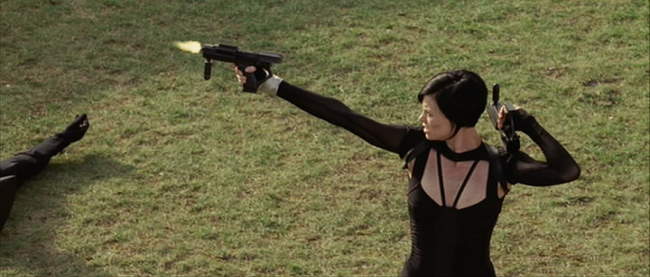
However, the narrative problems in Aeon Flux may be due more to ridiculous studio meddling than with the actual script – apparently the editing was one casualty of studio meddling. Phil Hay has indicated that he will write an essay on how the Director’s Cut would have been different. He is hoping that DVD sales will be high enough that the studio will agree to release the Director’s Cut, which he claims is a very different movie. Still, Charlize Theron’s excellent acrobatics makes for good eye candy, and turns in a credible performance as a humanized version of Aeon (the Trevor portrayal is completely uncrecognizable from the cartoon though). The visuals are terrific, and the technology is pretty interesting. Similar to other 6 star movies that are high on visuals but have problematic stories (Ultraviolet, T3, Appleseed), you may still be interested in giving this a watch.
~See movies similar to this one~
|


















































































